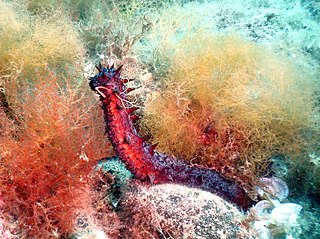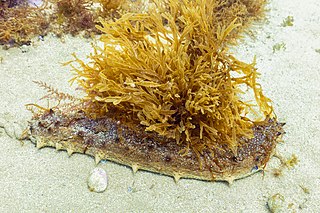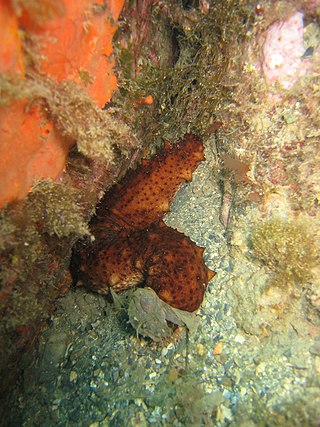
An echinoderm is any member of the phylum Echinodermata. The adults are recognisable by their radial symmetry, and include starfish, brittle stars, sea urchins, sand dollars, and sea cucumbers, as well as the sea lilies or "stone lilies". Adult echinoderms are found on the sea bed at every ocean depth, from the intertidal zone to the abyssal zone. The phylum contains about 7,000 living species, making it the second-largest grouping of deuterostomes, after the chordates. Echinoderms are the largest entirely marine phylum. The first definitive echinoderms appeared near the start of the Cambrian.

Sea cucumbers are echinoderms from the class Holothuroidea. They are marine animals with a leathery skin and an elongated body containing a single, branched gonad. Sea cucumbers are found on the sea floor worldwide. The number of holothurian species worldwide is about 1,717, with the greatest number being in the Asia-Pacific region. Many of these are gathered for human consumption and some species are cultivated in aquaculture systems. The harvested product is variously referred to as trepang, namako, bêche-de-mer, or balate. Sea cucumbers serve a useful role in the marine ecosystem as they help recycle nutrients, breaking down detritus and other organic matter, after which bacteria can continue the decomposition process.

A fish hatchery is a place for artificial breeding, hatching, and rearing through the early life stages of animals—finfish and shellfish in particular. Hatcheries produce larval and juvenile fish, shellfish, and crustaceans, primarily to support the aquaculture industry where they are transferred to on-growing systems, such as fish farms, to reach harvest size. Some species that are commonly raised in hatcheries include Pacific oysters, shrimp, Indian prawns, salmon, tilapia and scallops.

Sea cucumbers are marine animals of the class Holothuroidea. They can be used as food, in fresh or dried form, in various cuisines. In some cultural contexts the sea cucumber is thought to have medicinal value.

Holothuria atra, commonly known as the black sea cucumber or lollyfish, is a species of marine invertebrate in the family Holothuriidae. It was placed in the subgenus Halodeima by Pearson in 1914, making its full scientific name Holothuria (Halodeima) atra. It is the type species of the subgenus.

Holothuria mexicana, the donkey dung sea cucumber, is commonly found in the Caribbean and the Azores. It is a commercially important aspidochirote sea cucumber that can reach a total length of 50 cm (20 in).

Australostichopus is a genus of sea cucumbers in the family Stichopodidae. It is monotypic, being represented by the single species Australostichopus mollis, commonly known as the brown sea cucumber or Australasian sea cucumber. This species has stimulated interest for its fishery potential in the Southern Hemisphere, and for its capability to reduce waste produced by aquaculture. Despite its ecological role and abundance in New Zealand coastal waters, the scarcity of knowledge regarding A. mollis biology and ecology has hindered the development of a stable fishery industry. Importantly, A. mollis represents promising business potential within an important Asian market. Recently its potential as a functional food has been evaluated, highlighting the nutritious components

Holothuria forskali, the black sea cucumber or cotton-spinner, is a species of sea cucumber in the family Holothuriidae. It is found at shallow depths in the eastern Atlantic Ocean and the Mediterranean Sea. It was placed in the subgenus Panningothuria by Rowe in 1969 and is the typetaxon of the subgenus.

Holothuria scabra, or sandfish, is a species of sea cucumber in the family Holothuriidae. It was placed in the subgenus Metriatyla by Rowe in 1969 and is the type species of the subgenus. Sandfish are harvested and processed into "beche-de-mer" and eaten in China and other Pacific coastal communities.

Sea cucumber stocks have been overexploited in the wild, resulting in incentives to grow them by aquaculture. Aquaculture means the sea cucumbers are farmed in contained areas where they can be cultured in a controlled manner. In China, sea cucumbers are cultured, along with prawns and some fish species, in integrated multi-trophic systems. In these systems, the sea cucumbers feed on the waste and feces from the other species. In this manner, what would otherwise be polluting byproducts from the culture of the other species become a valuable resource that is turned into a marketable product.

Holothuria tubulosa, the cotton-spinner or tubular sea cucumber, is a species of sea cucumber in the family Holothuriidae. It is the type species of the genus Holothuria and is placed in the subgenus Holothuria, making its full name Holothuria (Holothuria) tubulosa.
Entovalva nhatrangensis is a species of small marine bivalve mollusc in the family Lasaeidae. It was first described in 2010 and its specific name "nhatrangensis" derives from the locality where it was originally found, Nha Trang Bay in Vietnam. It lives inside the oesophagus of certain species of sea cucumbers. It is considered to be an endosymbiont rather than a parasite because it does not harm its host.

Apostichopus japonicus is a species of sea cucumber in the family Stichopodidae. It is found in shallow temperate waters along the coasts of south east Asia and is commonly known as the Japanese spiky sea cucumber or the Japanese sea cucumber.

Holothuria edulis, commonly known as the edible sea cucumber or the pink and black sea cucumber, is a species of echinoderm in the family Holothuriidae. It was placed in the subgenus Halodeima by Pearson in 1914, making its full scientific name Holothuria (Halodeima) edulis. It is found in shallow water in the tropical Indo-Pacific Ocean.

Cucumaria vegae, also known as tiny black sea cucumber or northern tar spot, is a species of sea cucumber. It was first described to science by Johan Hjalmar Théel in 1886 reporting on the sea cucumber specimens brought back by the Challenger expedition. Among these was the type specimen for this species, which was collected at Bering Island.
Holothuria grisea, the gray sea cucumber, is a mid-sized coastal species of sea cucumber found in shallow tropical waters of the Atlantic Ocean from Florida to Southern Brazil and West Africa. They have a variety in color and can range from red to more yellowish with brown markings. They are also a food source for local and international markets with the majority of harvesting taking place in Brazil. This species is currently not over-fished and is not endangered or threatened.

Holothuria arguinensis is a species of sea cucumber in the family Holothuriidae and subgenus Roweothuria. It is found in waters off the northeast Atlantic Ocean and Mediterranean Sea. According to some scholarly research, the species is actively expanding its range and colonizing the south-eastern coast of Spain.

Holothuria stellati, also known as the brown sea cucumber,is a species of sea cucumber in the family Holothuriidae. First described by Delle Chiaje in 1824. There are two accepted subspecies, Holothuria stellatidakarensis and Holothuria stellati mammata, though there is still debate on whether or not they are separate species.
Holothuria (Cystipus) cubana is a species of sea cucumber in the family Holothuriidae. This species was first described by Ludwig in 1875.
















